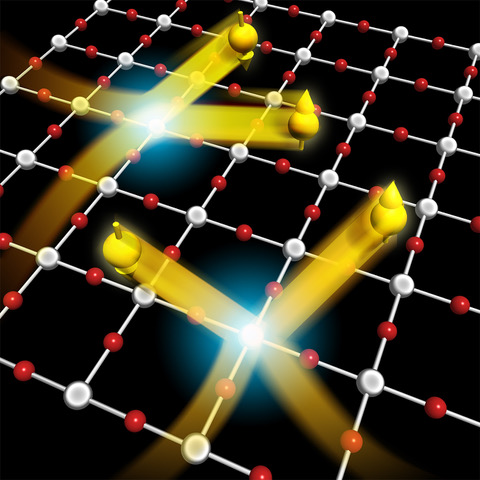- Quantum crystal structure in the 250-kelvin superconducting lanthanum hydride
-
Nature 578, 66(2020)

The discovery of superconductivity at 200K in the hydrogen sulfide system at high pressures demonstrated the potential of hydrogen-rich materials as high-temperature superconductors. Recent theoretical predictions of rare-earth hydrides with hydrogen cages and the subsequent synthesis of LaH10 with a superconducting critical temperature (Tc) of 250K have placed these materials on the verge of achieving the long-standing goal of room-temperature superconductivity. Electrical and X-ray diffraction measurements have revealed a weakly pressure-dependent Tc for LaH10 between 137 and 218 GPa in a structure that has a face-centred cubic arrangement of lanthanum atoms. Here we show that quantum atomic fluctuations stabilize a highly symmetrical Fm-3m crystal structure over this pressure range. The structure is consistent with experimental findings and has a very large electron-phonon coupling constant of 3.5. Although ab initio classical calculations predict that this Fm-3m structure undergoes distortion at pressures below 230 GPa, yielding a complex energy landscape, the inclusion of quantum effects suggests that it is the true ground-state structure. The agreement between the calculated and experimental Tc values further indicates that this phase is responsible for the superconductivity observed at 250 K. The relevance of quantum fluctuations calls into question many of the crystal structure predictions that have been made for hydrides within a classical approach and that currently guide the experimental quest for room-temperature superconductivity. Furthermore, we find that quantum effects are crucial for the stabilization of solids with high electron-phonon coupling constants that could otherwise be destabilized by the large electron-phonon interaction, thus reducing the pressures required for their synthesis.
- Formation of a two-dimensional single-component correlated electron system and band engineering in the nickelate superconductor NdNiO2
-
Phys. Rev. B 100, 205138 (2019) Editors' suggestion

Motivated by the recent experimental discovery of superconductivity in the infinite-layer nickelate Nd0.8Sr0.2NiO2 [Li et al., Nature (London) 572, 624 (2019)], we study how the correlated Ni 3dx2−y2 electrons in the NiO2 layer interact with the electrons in the Nd layer. We show that three orbitals are necessary to represent the electronic structure around the Fermi level: Ni 3dx2−y2, Nd 5d3z2-r2, and a bonding orbital made from an interstitial s orbital in the Nd layer and the Nd 5dxy orbital. By constructing a three-orbital model for these states, we find that the hybridization between the Ni 3dx2−y2 state and the states in the Nd layer is tiny. We also find that the metallic screening by the Nd layer is not so effective in that it reduces the Hubbard U between the Ni 3dx2-y2 electrons just by 10%-20%. On the other hand, the electron-phonon coupling is not strong enough to mediate superconductivity of Tc~10 K. These results indicate that NdNiO2 hosts an almost isolated correlated 3dx2-y2 orbital system. We further study the possibility of realizing a more ideal single-orbital system in the Mott-Hubbard regime. We find that the Fermi pockets formed by the Nd-layer states dramatically shrink when the hybridization between the interstitial s state and Nd 5dxy state becomes small. By an extensive materials search, we find that the Fermi pockets almost disappear in NaNd2NiO4 and NaCa2NiO3.
- Exotic pairing state in quasicrystalline superconductors under a magnetic field
-
Phys. Rev. Res., 1 022002 (2019)(featured in Physics)
We theoretically study the effect of a magnetic field on quasicrystalline superconductors, by modeling them as an attractive Hubbard model on a Penrose-tiling structure. We find that at low temperatures and under a high magnetic field there appears an exotic superconducting state with the order parameter changing its sign in real space. We discuss the state in comparison with the Fulde-Ferrell-Larkin-Ovchinnikov state proposed many years ago for periodic systems, clarifying commonalities and differences. It is remarkable that, even in the absence of periodicity, the electronic system finds a way to keep a coherent superconducting state with a spatially sign-changing order parameter compatible with the underlying quasiperiodic structure.
- Multipole expansion for magnetic structures: A generation scheme for a symmetry-adapted orthonormal basis set in the crystallographic point group
-
Phys. Rev. B, 99 174407 (2019) (Editors' suggestion)
We propose a systematic method to generate a complete orthonormal basis set of multipole expansion for magnetic structures in arbitrary crystal structure. The key idea is the introduction of a virtual atomic cluster of a target crystal on which we can clearly define the magnetic configurations corresponding to symmetry-adapted multipole moments. The magnetic configurations are then mapped onto the crystal so as to preserve the magnetic point group of the multipole moments, leading to the magnetic structures classified according to the irreducible representations of the crystallographic point group. We apply the present scheme to pyrochlore and hexagonal ABO3 crystal structures and demonstrate that the multipole expansion is useful to investigate the macroscopic responses of antiferromagnets.
- Cluster multipole dynamics in noncollinear antiferromagnets
-
Phys. Rev. Res. 2 012045 (R) (2020)
A systematic framework to investigate the spin dynamics in a noncollinear antiferromagnet is proposed. Taking Mn3Sn as a representative example, we derive an effective low-energy model based on the multipole expansion of the magnetic structure, and investigate the uniform precession and the domain wall dynamics. We show that the solution for the effective model accurately reproduces the numerical calculation of the Landau-Lifshitz-Gilbert equations. Our results indicate that Mn3Sn has preferable properties for applications to a racetrack memory and a spin torque oscillator, and thus is a promising candidate for spintronics devices by using the multipole degrees of freedom.




